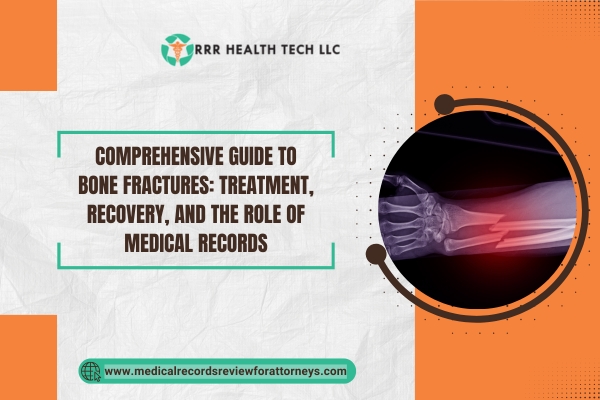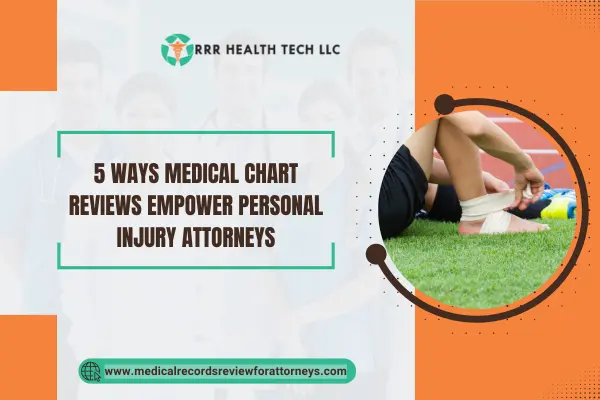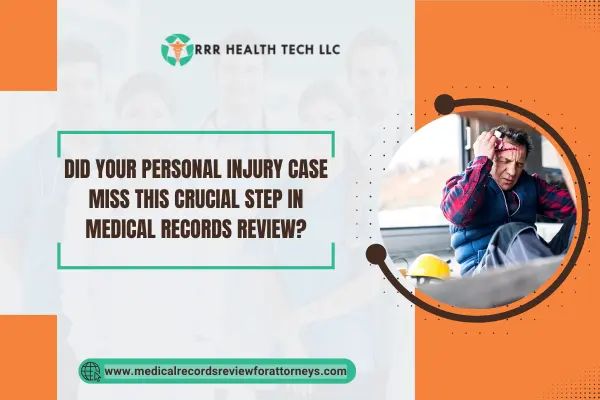
Introduction
Fractures are one of the most common injuries that occur, and may require the intervention of a medical professional to help the person get back to their normal state of life. For patients and lawyers, knowing the available treatment options, the recovery stages, and how medical records assist in the management of these cases is very important. We are a medical record review company working with attorneys throughout the United States, and we know how precise medical documentation can help in legal issues concerning bone fractures. This article strives to provide an exhaustive description of bone fractures, how they are managed, and how medical records impact their legal representation.
Overview of Bone Fractures
Definition of Bone Fractures
When a continuity of bone incurs a break, the medical condition is termed as bone fracture. The bone can fracture from external trauma, overuse, or if there is a medical disease present that weakens it.
Types of Bone Fractures
• Closed Fractures: A fracture where the skin remains intact.
• Open Fractures: A fracture where the broken bone can be seen through the skin.
• Greenstick Fractures: Fractures common in children which are not completed, but cause bending and cracking of the bone.
• Comminute Bone Fracture: The bone is broken into fragments and often needs surgery.
Statistics on Bone Fractures
According to the National Institutes of Health (NIH), approximately 6 million fractures occur in the United States each year, with a significant portion requiring surgical treatment and rehabilitation.
Treatment Options for Bone Fractures
Initial Assessment and Diagnosis
• Physical Examination: An examination which physically assesses the injury and decides on the level of those injuries.
• Imaging Tests: Includes the use of X-rays, CT scans, or MRIs in order to figure out what kind and how bad the fractures are.
Treatment Methods
Non-Surgical Treatments
• Immobilization: It is the method of either a cast or splint that keeps the bone immobilized and in a certain position when healing is about to take place.
• Pain Management: A way to manage either with some pain relief medication and even prescribed medicine for inflammation and pain.
Surgical Treatments
• Internal Fixation: The process or tactic in surgery of mending fractured bones such as in a thigh bone by fixing plates, screws or intramedullary rods as form of internal stabilization.
• External Fixation: Stabilizing a fracture by means of a frame secured to the bone through the skin.
Rehabilitation and Recovery
• Physical Therapy: Treatment that restores power and movement efficacy after the fracture occurred.
• Follow up Care: Consist of interval check-ups to keep track of healing and attending to any concerns that may arise.
The Role of Medical Records in Fracture Cases
Importance of Accurate Medical Documentation
Medical records are vital in managing fracture cases, providing:
• Proof of Injury – Accounts of the injury sustained and the treatment done.
• Treatment History – recorded medical actions as well as stages of healing.
• Impact in Daily Life – Demonstrates how the injury changes the victim’s normal activities and employment potential.
How We Assist Attorneys
Our medical records review services help attorneys by:
- Thorough Review: We meticulously analyze medical records to ensure accuracy and relevance.
- Summarization: Providing concise summaries that highlight key information supporting the case.
- Expert Testimony Preparation: Assisting in preparing expert testimony based on medical records to strengthen the case.
Case Studies
Case Study 1: John vs. Construction Company
• Overview: John has a fracture of the leg sustained from a fall while he was on scaffolding at a building site.
• Challenge: Proving that the construction company was at fault for not providing a conducive working environment.
• Solution: Medical records were incorporated in the proof of the claim to demonstrate the level of injury and treatment received. Expert testimony was also prepared using these records to prove the case.
Case Study 2: Jane Smith vs. Retail Store
• Overview: Jane Smith broke her wrist when she slipped on a wet floor in a retail store.
• Challenge: Jane’s injuries and proving the store’s liability.
• Solution: Medical records detailing Jane’s treatment and recovery were provided. Furthermore, expert evaluation was performed to prove the store’s negligence in providing a safe working environment.
Conclusion
Bone fractures can fundamentally alter a person’s life which is why the treatment and recovery options must be carefully planned. Accurate medical records are equally as important because they form the basis to prove the legal case and guarantee representation to victims. Attorneys are able to improve their cases with the help of our services in the review of medical records which consequently helps the victims receive the justice they deserve.


